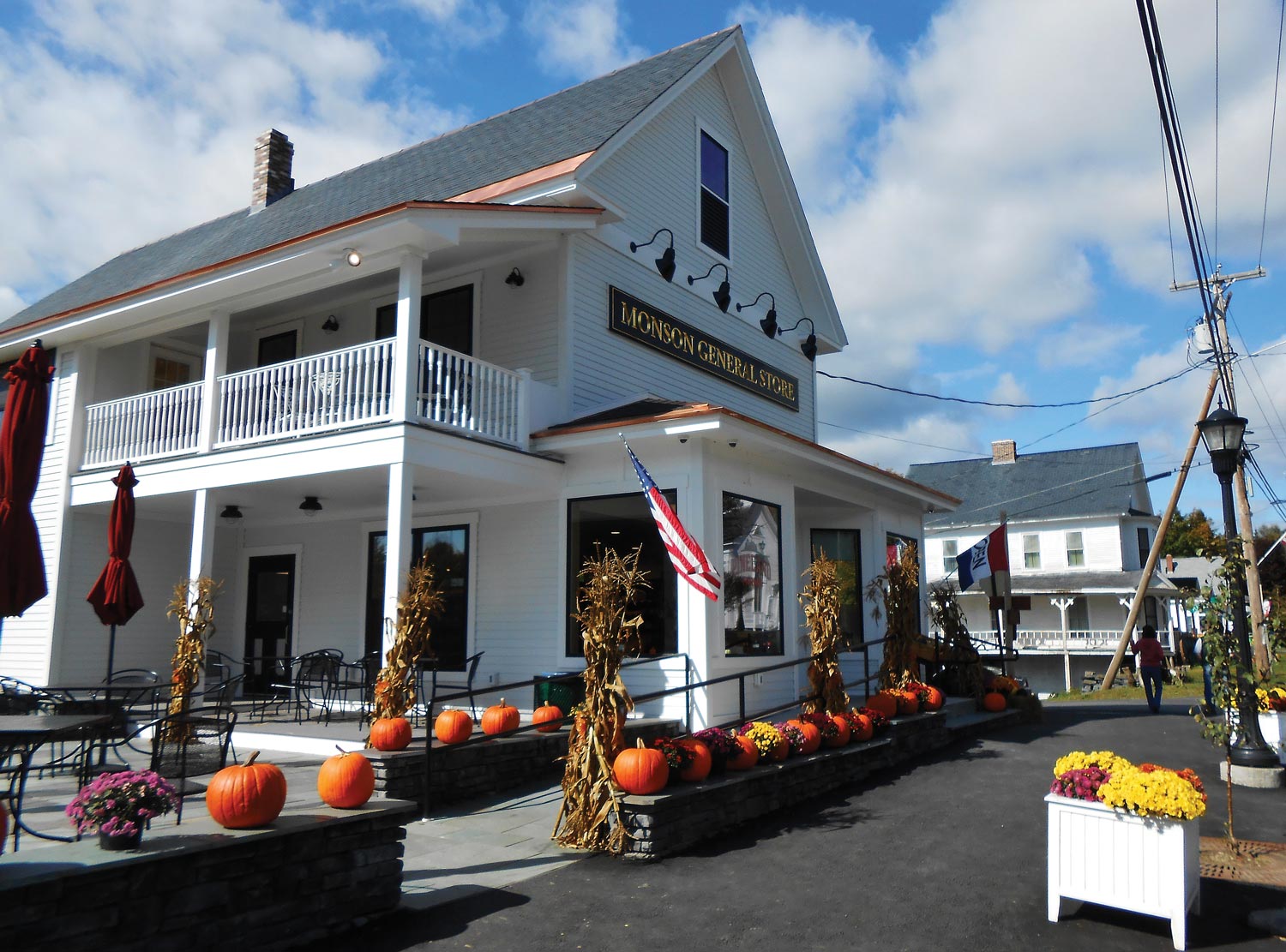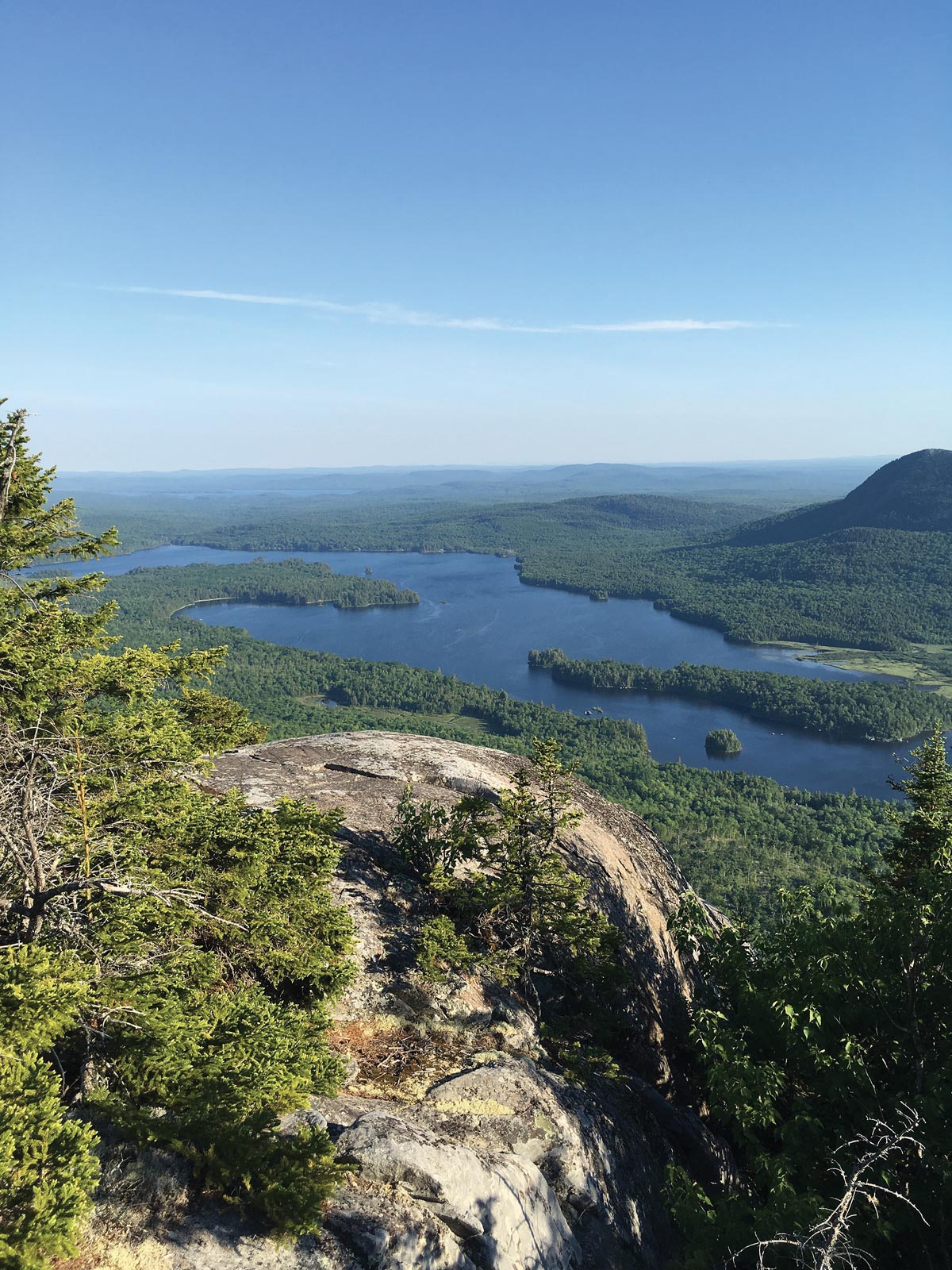

![]() illustration katie eberts
illustration katie eberts
landscape partnership approach that helps preserve the essence of the A.T. experience — its view shed, access to the Trail, and the vitality of communities along it — there is no better place to examine than Maine’s North Woods. “Cooperating with multiple partners to preserve large landscapes is the future of protecting the Trail experience,” says the Appalachian Trail Conservancy’s (ATC) president and CEO Ron Tipton. “This of course is not limited to Maine, but all the way to Georgia too.” He explains that this isn’t about protecting the footpath, which is already protected. It’s about the larger landscape. “When you’re looking at a really large area with the potential to protect thousands of acres it will almost always involve working with numerous private and public partners,” he says. “It will never be the ATC by ourselves.”
 key partner in this endeavor is the National Park Service (NPS) Appalachian National Scenic Trail office (APPA). “[Our] participation in A.T. Landscape Protection aligns seamlessly with the NPS promotion of large landscape conservation to support healthy ecosystems and cultural resources,” says APPA superintendent Wendy Janssen. “As Benton MacKaye wrote, ‘…a realm and not merely a trail mark the full aim of our efforts.’”
key partner in this endeavor is the National Park Service (NPS) Appalachian National Scenic Trail office (APPA). “[Our] participation in A.T. Landscape Protection aligns seamlessly with the NPS promotion of large landscape conservation to support healthy ecosystems and cultural resources,” says APPA superintendent Wendy Janssen. “As Benton MacKaye wrote, ‘…a realm and not merely a trail mark the full aim of our efforts.’”
Walter Graff, the senior vice president of the Appalachian Mountain Club (AMC), is someone who’s not afraid of gutsy land conservation projects himself. For example, in 2001 he helped establish the largest town-owned forest in New Hampshire that encompasses over 10,000 acres in his hometown of Randolph. While that project was a grassroots community effort, it paralleled his decades-long career at the AMC, an organization that is no stranger to major conservation projects.
“When we created a town forest we did it as volunteers. That got me thinking, can the AMC do this somewhere else?” Graff said. While his contemplation would represent a new frontier in the AMC’s conservation playbook, it coincided with one of the largest land ownership changes in the northeastern U.S. in nearly a century. An upheaval in the timber industry preceded the transfer of ownership of hundreds of thousands of acres of commercial timberland throughout the state of Maine in the late 1990s.
Soon, the AMC as well as other conservation advocates and organizations swept in to protect some of Maine’s most special and remote places. For example, in 2003, the AMC purchased the first of several sprawling tracts that formed the nucleus of the AMC’s Maine Woods Initiative (MWI) — a project that combines outdoor recreation, resource protection, sustainable forestry, and community partnerships in Maine’s 100-Mile Wilderness region. In all, the MWI encompasses a contiguous stretch of over 70,000 acres of permanently conserved land. The thriving venture is one of several large-scale landscape projects that has placed in permanent protection thousands of acres of some of New England’s most remote and remarkable terrain that is adjacent to or encompasses the Appalachian Trail.
The success of the MWI is an example of an ambitious approach to land protection that the Appalachian Trail Conservancy (ATC) and many of its conservation partners — including the AMC, the Trust for Public Land, and the National Park Service. This kaleidoscope of organizations, from small volunteer groups to sprawling federal agencies, have championed this approach in order to protect priority landscapes throughout the A.T. corridor. Among them, the ATC has identified 10 Priority Landscapes, two of which are in Maine: the 100-Mile Wilderness and the High Peaks region. This initiative is called the “A.T. Landscape Partnership” and it includes a number of conservation organizations.
“We all champion the same thing: maintaining a sense of place, clean water,beautiful views, remoteness — those values are just as important to the people who live near the Trail as they are to a thru-hiker.”

The Monson General Store – Monson, Maine is one of many local A.T. Communities who have partnered with the ATC to preserve their unique character and special resources and to help protect those resources.
![]() Photo by Wendy Weiger
Photo by Wendy Weiger
 director of Landscape Conservation Dennis Shaffer believes the MWI had major benefits to the Trail experience and aligns with the ATC’s landscape level conservation values while allowing public access, and other management decisions that could impact the A.T. “What they’ve accomplished in terms of land protection, Trail development, and a recreational economy is remarkable. AMC had a big vision and they stuck to it,” says Shaffer. “It’s a real success story of one of our partner’s doing large landscape conservation work in the A.T. corridor.”
director of Landscape Conservation Dennis Shaffer believes the MWI had major benefits to the Trail experience and aligns with the ATC’s landscape level conservation values while allowing public access, and other management decisions that could impact the A.T. “What they’ve accomplished in terms of land protection, Trail development, and a recreational economy is remarkable. AMC had a big vision and they stuck to it,” says Shaffer. “It’s a real success story of one of our partner’s doing large landscape conservation work in the A.T. corridor.”
Shaffer explains that the partnerships between the ATC and other organizations such as the National Park Service, the Trust for Public Land, the AMC, and many local land trusts and organizations managed by volunteers take many forms. He points out that as conservation projects expand beyond the Trail corridor, they will likely become vastly more complex and will depend on a division of labor supplied by a diverse range of partners. “Our partners bring to the table a wide range of capacity and expertise. Our role with AMC has been more to help promote and celebrate the huge successes of their Maine Woods Initiative and to make the connection that this important work in Maine contributes to the entire A.T. landscape,” Shaffer explains. “But our work with partners such as AMC also goes well beyond specific projects areas like the MWI. We work closely on issues important to the entire A.T. landscape such as conservation funding initiatives, federal and state legislative issues, and active threats such as inappropriately planned pipelines or communications facilities.”
Other partners in Maine also had huge successes that contributed to protecting the A.T. landscape. In 1998, Karin Tilberg, now the interim executive director of the Forest Society of Maine, was working for the Northern Forest Alliance when there was a rather abrupt transformation in land ownership throughout the state. “We saw in two years, millions of acres sold in Maine,” recalls Tilberg. “We couldn’t get our heads around it. It was so dramatic.”
What she observed was that large timber companies were selling millions of acres of forest land in Maine’s Northwoods, a vast landscape of timberlands, lakes, and rivers that cover nearly half of the state. Much of it was privately owned and managed for industrial timber harvesting and the forest product industry had, for two centuries, produced everything from fine furniture to clothes pins and paper.
While conservation organizations had been eyeing protection possibilities in Maine for decades, much of the forest land was owned by a dozen or so large paper companies. Tilberg explains that it made sense for paper companies to own their own forest land to access a reliable supply of timber and water power. But global competition in the paper and timber industry tightened profits, triggering pressure from forest land owners to monetize their land assets. In a short period of time, fiscally battered timberland owners began to sell off tracts of land to timber management investment trusts and other buyers.
Tilberg said that for conservationists, land that had been tied up in ownership, now on the open market was a game changer. While an opportunity, there was a sense of urgency: communities were concerned that future land sales had the potential to fragment large tracts of forestland that had been owned by fewer than a dozen companies and had thus remained relatively intact and contiguous. “One key goal of local communities, forest products companies, and recreation interests was to stabilize and to prevent fragmentation. As land sells you have the potential to create more inholdings which works against forest management and you can potentially lose the [quality] of such a vast landscape,” says Tilberg.
While the timber land sell off of 98-99 was unexpected, the Maine conservation community wasn’t entirely unprepared. For years, land protection advocates had spent time connecting with locals in the remote forest gateway communities of working forests. “There were public meetings and listening sessions to talk about what people cared about,” recalls Tilberg. “In these communities people depend on working landscapes, but didn’t want to see land developed either, or to lose that sense of remoteness. What we learned was that [many goals overlapped].”
 turned out that the revelation of building stronger ties with communities would serve them well as forest land in Maine was put up for grabs. While land conservation organizations were facing an opportunity of a lifetime, plenty of Mainers weren’t entirely comfortable with a change in the status quo of land ownership that once reigned.
turned out that the revelation of building stronger ties with communities would serve them well as forest land in Maine was put up for grabs. While land conservation organizations were facing an opportunity of a lifetime, plenty of Mainers weren’t entirely comfortable with a change in the status quo of land ownership that once reigned.
Among the concerns of communities throughout Maine is the potential of being locked out of land they’ve accessed for generations to earn a living, hunt or fish, or snowmobile as part of a social compact between companies and residents. Laura Belleville, the ATC’s vice president of conservation and Trail programs, emphasizes that large-scale conservation projects won’t succeed without paying careful attention to how people live, work, and play within the landscape. “The work that the AMC is doing in Maine really shines a light on how compatible recreational conservation goals can be with local communities,” explains Belleville. “We all champion the same thing: maintaining a sense of place, clean water, beautiful views, remoteness — those values are just as important to the people who live near the Trail as they are to a thru-hiker.”
The ATC has been working to connect communities along the A.T. to these benefits through the A.T. Community program. Several communities in Maine have been designated partners of the ATC and local Trail clubs, including Millinocket, Monson, Rangeley, and Kingfield. These communities recognize that the A.T. is a draw for visitors that want to explore this world renowned treasure and that they serve as gateways to that experience. The Trail and the surrounding landscape contribute to a recreation-based tourism economy that helps these small communities preserve their unique character and special resources. Communities are also partnering with the ATC to help protect these resources through outreach strategies such as the new A.T. visitor center in Monson.
Lucas St. Clair, an A.T. advocate and thru-hiker in 1997, along with his family’s foundation, the Quimby Family Foundation, has been a major driver behind the creation of the 87,000 acres Katahdin Woods and Waters National Monument in Maine. He said that there are lessons about large-scale conservation that can be shared whether a private- or public-led land project. “People were unsure of what a national monument would bring, as far as rules, regulations and restrictions to a property that they had access historically,” he says. “The ways that we addressed it was to meet it head on and have interactions with communities with a lot of listening to understand what was important to them. I’d say the most important thing is engagement early and often with the community that will be affected.”
So when the AMC embarked on their Maine Woods Initiative, they knew that building a recreational wilderness would also involve an understanding of the local economies that would be impacted. In the mid 1990s, the AMC was forging a multi-year strategic plan that included a recreational land base that was owned by the organization. The board’s target was 100,000 acres. Eventually, in 2003, the AMC identified a 27,000 acres tract of land that International Paper was preparing to put on the market contiguous to the Appalachian Trail. Tilberg, who was then serving as a senior conservation policy adviser to Maine Governor John Baldacci, helped lay the groundwork for the sale. Since then, the AMC has added several other chunks of land to bring it to a present total of 70,000 acres.
“Overall the response in the community has been positive, but it wasn’t easy,” Graff admits, adding that it took a decade to develop connections and become part of the communities impacted by the AMC’s project. Among the core values of the project was to recognize that the woods product industry is a backbone of the local economy. “It’s not our goal to replace timber harvesting with wilderness recreation, but rather to integrate the two.”
“Cooperating with multiple partners to preserve large landscapes is the future of protecting the Trail experience, not just in Maine, but all the way to Georgia too.”

View of Lake Onawa from Barren Ledges in Maine — protecting the landscape may be an enticing draw to future visitors both from an environmental and economic standpoint.
![]() Photo by Kim Rosenbaum
Photo by Kim Rosenbaum
 Tipton says that among the ATC’s closest partnership is with the Trust for Public Land (TPL). Over the years, the TPL has assisted or led projects that have direct benefits to the A.T., including assisting the AMC with their first MWI purchase in 2003. Among their current projects is the protection of 2,500 acres around Bald Mountain Pond (BMP), an undeveloped lake that’s prized for its natural beauty, a century-old forest stand, and its population of rare landlocked Arctic char. The protection will also secure an important buffer to the Trail and will protect the view of the pond from Bald Mountain Shelter. “You really don’t want to see the lights of houses and smell gas grills. The BMP project helps maintain the sense of being in the big woods, which is what’s so special about Maine,” said TPL senior project manager, J.T. Horn.
Tipton says that among the ATC’s closest partnership is with the Trust for Public Land (TPL). Over the years, the TPL has assisted or led projects that have direct benefits to the A.T., including assisting the AMC with their first MWI purchase in 2003. Among their current projects is the protection of 2,500 acres around Bald Mountain Pond (BMP), an undeveloped lake that’s prized for its natural beauty, a century-old forest stand, and its population of rare landlocked Arctic char. The protection will also secure an important buffer to the Trail and will protect the view of the pond from Bald Mountain Shelter. “You really don’t want to see the lights of houses and smell gas grills. The BMP project helps maintain the sense of being in the big woods, which is what’s so special about Maine,” said TPL senior project manager, J.T. Horn.
Horn said that anchoring the TPL’s work along the A.T. corridor is a way to link people with the best of Maine’s North Woods, but it’s not the only reason for the partnership with the ATC. “Just from a mission alignment view, working with the ATC is a really good fit. Our mission is conserving land for people. One of the best places people can experience the grandeur and remoteness of the North Woods is along the Trail, so anchoring our land conservation work along one of the iconic destinations in the North Woods makes sense,” explains Horn. On the other hand, he says that there’s a less flashy, but just as vital reason for partnering with the ATC. “At a practical level, the ATC is really helpful at creating the case for public funding for conservation. We also know that there will be an impressive cadre of volunteers to steward the land after we buy it.”
But at the core of a successful landscape-level conservation project in the A.T. corridor is helping support and bolster the communities that lie within it. Putting the environmental benefits aside, protecting the landscape may be an enticing draw to future visitors to Maine and a viable option for bolstering the vitality of communities that are looking for other ways to diversify their economic base and generate income from a working landscape. “The breadth and scope of the MWI and other projects are extraordinary, but in the eastern U.S. unique to Maine. So as we go beyond the scope of the footpath and corridor, we’re looking at a combination of other strategies — conservation easements or land swaps, for example — that don’t involve buying thousands of acres,” says Tipton.
And while the scale of conservation in the North Woods may not be possible to replicate in other regions of the Appalachians, if the success in Maine serves as a guide, then engaging communities and building meaningful partnerships, will most likely remain the cornerstone of the ATC’s future conservation strategy for a long time to come.
For more information about the A.T. Landscape Partnership visit: appalachiantrail.org/Landscape